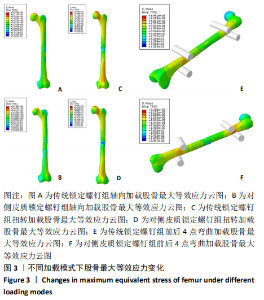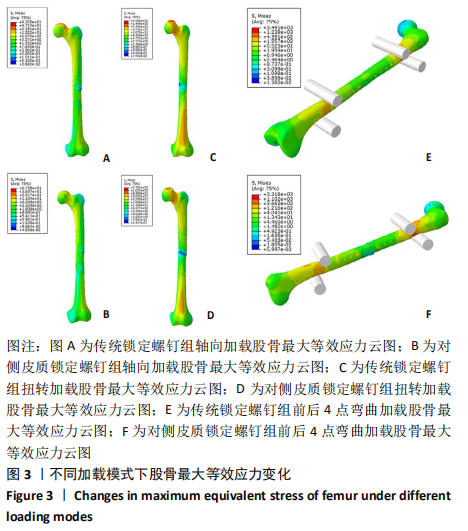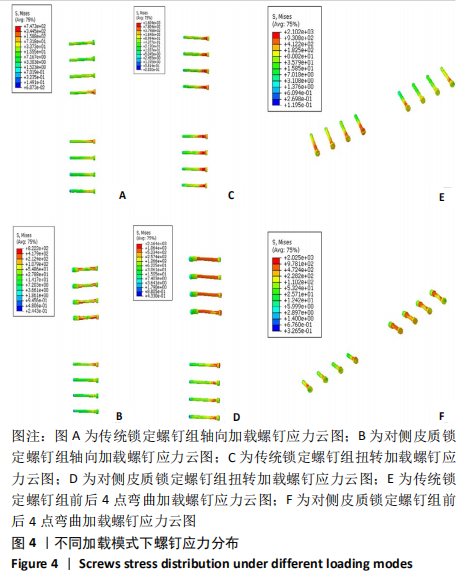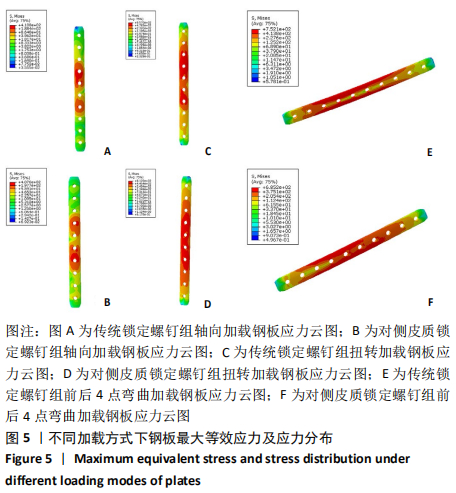Chinese Journal of Tissue Engineering Research ›› 2021, Vol. 25 ›› Issue (24): 3832-3837.doi: 10.12307/2021.088
Previous Articles Next Articles
Finite element analysis for treatment of osteoporotic femoral fracture with far cortical locking screw
Zhu Yun, Chen Yu, Qiu Hao, Liu Dun, Jin Guorong, Chen Shimou, Weng Zheng
- Center for Traumatology (Orthopedic Ward), Ninth People’s Hospital of Chongqing, Chongqing 400700, China
-
Received:2020-08-05Revised:2020-08-08Accepted:2020-09-15Online:2021-08-28Published:2021-03-08 -
Contact:Weng Zheng, Attending physician, Center for Traumatology (Orthopedic Ward), Ninth People’s Hospital of Chongqing, Chongqing 400700, China -
About author:Zhu Yun, Master, Attending physician, Center for Traumatology (Orthopedic Ward), Ninth People’s Hospital of Chongqing, Chongqing 400700, China -
Supported by:the Scientific Research Project of Beibei Science and Technology Committee of Chongqing, No. 2019-7 (to ZY)
CLC Number:
Cite this article
Zhu Yun, Chen Yu, Qiu Hao, Liu Dun, Jin Guorong, Chen Shimou, Weng Zheng. Finite element analysis for treatment of osteoporotic femoral fracture with far cortical locking screw[J]. Chinese Journal of Tissue Engineering Research, 2021, 25(24): 3832-3837.
share this article
Add to citation manager EndNote|Reference Manager|ProCite|BibTeX|RefWorks
| [1] HENDERSON CE, BOTTLANG M, MARSH JL, et al. Does locked plating of periprosthetic supracondylar femur fractures promote bone healing by callus formation? Two cases with opposite outcomes. Iowa Orthop J. 2008;28:73-76. [2] LUJAN TJ, HENDERSON CE, MADEY SM, et al. Locked plating of distal femur fractures leads to inconsistent and asymmetric callus formation. J Orthop Trauma. 2010;24(3):156-162. [3] GARDNER MJ, NORK SE, HUBER P, et al. Stiffness modulation of locking plate constructs using near cortical slotted holes: a preliminary study. J Orthop Trauma. 2009;23(4):281-287. [4] BOTTLANG M, DOORNINK J, BYRD GD, et al. A nonlocking end screw can decrease fracture risk caused by locked plating in the osteoporotic diaphysis. J Bone Joint Surg Am. 2009;91(3):620-627. [5] LE L, JABRAN A, PEACH C, et al. Effect of screw thread length on stiffness of proximal humerus locking plate constructs: a finite element study. Med Eng Phys. 2019;63:79-87. [6] GOUK CJC, BINDRA RR, TARRANT DJ, et al. Volar locking plate fixation versus external fixation of distal radius fractures: a meta-analysis. J Hand Surg Eur Vol. 2018;43(9):954-960. [7] GUEORGUIEV B, LENZ M. Why and how do locking plates fail? Injury. 2018;49 Suppl 1:S56-S60. [8] BOTTLANG M, DOORNINK J, FITZPATRICK DC, et al. Far cortical locking can reduce stiffness of locked plating constructs while retaining construct strength. J Bone Joint Surg Am. 2009;91(8):1985-1994. [9] 中华医学会骨质疏松和骨矿盐疾病分会.原发性骨质疏松症诊疗指南(2017)[J].中华骨质疏松和骨矿盐疾病杂志,2017,10(5): 413-444. [10] POLIKEIT A, NOLTE LP, FERGUSON SJ. The effect of cement augmentation on the load transfer in an osteoporotic functional spinal unit. Spine. 2003;28(10):991-996. [11] BEL JC. Pitfalls and limits of locking plates. Orthop Traumatol Surg Res. 2019;105(1S):S103-S109. [12] HOTTMANN NM, JOHNSON MD, BANKS SA, et al. Biomechanical comparison of two locking plate constructs for the stabilization of feline tibial fractures. Vet Comp Orthop Traumatol. 2020;33(2):89-95. [13] YARBORO SR. Lateral distal femur plate for periprosthetic fracture. J Orthop Trauma. 2018;32 Suppl 1:S30-S31. [14] BURCHARD R, MASSA R, SOOST C, et al. Biomechanics of common fixation devices for first tarsometatarsal joint fusion-a comparative study with synthetic bones. J Orthop Surg Res. 2018;13(1):176. [15] KLUG A, GRAMLICH Y, BUCKUP J, et al. Excellent results and low complication rate for anatomic polyaxial locking plates in comminuted proximal ulna fractures. J Shoulder Elbow Surg. 2018;27(12):2198-2206. [16] WAJNSZTEJN A, PIRES RES, DOS SANTOS ALG, et al. Minimally invasive posteromedial percutaneous plate osteosynthesis for diaphyseal tibial fractures: technique description. Injury. 2017;48 Suppl 4:S6-S9. [17] JIN C, WENG D, YANG W, et al. Minimally invasive percutaneous osteosynthesis versus ORIF for Sanders type II and III calcaneal fractures: a prospective, randomized intervention trial. J Orthop Surg Res. 2017;12(1):10. [18] REISCH T, CAMENZIND RS, FUHRER R, et al. The first 100 patients treated with a new anatomical pre-contoured locking plate for clavicular midshaft fractures. BMC Musculoskelet Disord. 2019;20(1):4. [19] LAUX CJ, GRUBHOFER F, WERNER CML, et al. Current concepts in locking plate fixation of proximal humerus fractures. J Orthop Surg Res. 2017;12(1):137. [20] DEKEYSER GJ, KELLAM PJ, HALLER JM. Locked plating and advanced augmentation techniques in osteoporotic fractures. Orthop Clin North Am. 2019;50(2):159-169. [21] MEEUWIS MA, PULL TER GUNNE AF, VERHOFSTAD MH, et al. Construct failure after open reduction and plate fixation of displaced midshaft clavicular fractures. Injury. 2017;48(3):715-719. [22] VARKEY D, OSTRUM RF. ORIF with submuscular plating of an intercondylar/supracondylar distal femur fracture. J Orthop Trauma. 2018;32 Suppl 1:S28-S29. [23] WANG JQ, JIANG BJ, GUO WJ, et al. Serial changes in the head-shaft angle of proximal humeral fractures treated by placing locking plates: a retrospective study. BMC Musculoskelet Disord. 2018;19(1):420. [24] CHEN YN, CHANG CW, LI CT, et al. Biomechanical investigation of the type and configuration of screws used in high tibial osteotomy with titanium locking plate and screw fixation. J Orthop Surg Res. 2019;14(1):35. [25] HERNANDEZ MC, REISENAUER JS, AHO JM, et al. Bone autograft coupled with locking plates repairs symptomatic rib fracture nonunions. Am Surg. 2018;84(6):844-850. [26] JAEBLON T. Biomechanics of far cortical locking. J Orthop Trauma. 2011; 25(6):e60. [27] DÖBELE S, GARDNER M, SCHRÖTER S, et al. DLS 5.0-the biomechanical effects of dynamic locking screws. PLoS One. 2014;9(4):e91933. [28] YANG JC, LIN KP, WEI HW, et al. Importance of a moderate plate-to-bone distance for the functioning of the far cortical locking system. Med Eng Phys. 2018;56:48-53. [29] HAST MW, CHIN M, SCHMIDT EC, et al. Mechanical effects of bone substitute and far-cortical locking techniques in 2-part proximal humerus fracture reconstruction: a cadaveric study. J Orthop Trauma. 2020;34(4):199-205. [30] ELKINS J, MARSH JL, LUJAN T, et al. Motion predicts clinical callus formation: construct-specific finite element analysis of supracondylar femoral fractures. J Bone Joint Surg Am. 2016;98(4):276-284. [31] AUGAT P, BURGER J, SCHORLEMMER S, et al. Shear movement at the fracture site delays healing in a diaphyseal fracture model. J Orthop Res. 2003;21(6):1011-1017. [32] DUDA GN, SOLLMANN M, SPORRER S, et al. Interfragmentary motion in tibial osteotomies stabilized with ring fixators. Clin Orthop Relat Res. 2002;(396):163-172. [33] POTTER BK. From bench to bedside: how stiff is too stiff? far-cortical locking or dynamic locked plating may obviate the question. Clin Orthop Relat Res. 2016;474(7):1571-1573. [34] PRIMEAU CA, MARSH JD, BIRMINGHAM TB, et al. The importance of costing perspective: an example evaluating the cost-effectiveness of a locking versus nonlocking plate in medial opening wedge high tibial osteotomy. Can J Surg. 2019;62(1):E14-E16. [35] SCHRÖTER S, HOFFMANN T, DÖBELE S, et al. Biomechanical properties following open wedge high tibial osteotomy: Plate fixator combined with dynamic locking screws versus standard locking screws. Clin Biomech (Bristol, Avon). 2018;60:108-114. [36] TOTOKI Y, YOSHII Y, KUSAKABE T, et al. Screw length optimization of a volar locking plate using three dimensional preoperative planning in distal radius fractures. J Hand Surg Asian Pac Vol. 2018;23(4):520-527. [37] EBRAHEIM NA, LIU J, HASHMI SZ, et al. High complication rate in locking plate fixation of lower periprosthetic distal femur fractures in patients with total knee arthroplasties. J Arthroplasty. 2012;27(5): 809-813. [38] HABET N, ELKINS J, PEINDL R, et al. Far Cortical locking fixation of distal femur fractures is dominated by shear at clinically relevant bridge spans. J Orthop Trauma. 2019;33(2):92-96. [39] DOORNINK J, FITZPATRICK DC, MADEY SM, et al. Far cortical locking enables flexible fixation with periarticular locking plates. J Orthop Trauma. 2011;25 Suppl 1(Suppl 1):S29-34. [40] BOTTLANG M, FITZPATRICK DC, SHEERIN D, et al. Dynamic fixation of distal femur fractures using far cortical locking screws. J Orthop Trauma. 2014;28(4):181-188. |
| [1] | Xu Feng, Kang Hui, Wei Tanjun, Xi Jintao. Biomechanical analysis of different fixation methods of pedicle screws for thoracolumbar fracture [J]. Chinese Journal of Tissue Engineering Research, 2021, 25(9): 1313-1317. |
| [2] | Jiang Yong, Luo Yi, Ding Yongli, Zhou Yong, Min Li, Tang Fan, Zhang Wenli, Duan Hong, Tu Chongqi. Von Mises stress on the influence of pelvic stability by precise sacral resection and clinical validation [J]. Chinese Journal of Tissue Engineering Research, 2021, 25(9): 1318-1323. |
| [3] | Zhang Tongtong, Wang Zhonghua, Wen Jie, Song Yuxin, Liu Lin. Application of three-dimensional printing model in surgical resection and reconstruction of cervical tumor [J]. Chinese Journal of Tissue Engineering Research, 2021, 25(9): 1335-1339. |
| [4] | Zhang Yu, Tian Shaoqi, Zeng Guobo, Hu Chuan. Risk factors for myocardial infarction following primary total joint arthroplasty [J]. Chinese Journal of Tissue Engineering Research, 2021, 25(9): 1340-1345. |
| [5] | Wei Wei, Li Jian, Huang Linhai, Lan Mindong, Lu Xianwei, Huang Shaodong. Factors affecting fall fear in the first movement of elderly patients after total knee or hip arthroplasty [J]. Chinese Journal of Tissue Engineering Research, 2021, 25(9): 1351-1355. |
| [6] | Wang Jinjun, Deng Zengfa, Liu Kang, He Zhiyong, Yu Xinping, Liang Jianji, Li Chen, Guo Zhouyang. Hemostatic effect and safety of intravenous drip of tranexamic acid combined with topical application of cocktail containing tranexamic acid in total knee arthroplasty [J]. Chinese Journal of Tissue Engineering Research, 2021, 25(9): 1356-1361. |
| [7] | Xiao Guoqing, Liu Xuanze, Yan Yuhao, Zhong Xihong. Influencing factors of knee flexion limitation after total knee arthroplasty with posterior stabilized prostheses [J]. Chinese Journal of Tissue Engineering Research, 2021, 25(9): 1362-1367. |
| [8] | Huang Zexiao, Yang Mei, Lin Shiwei, He Heyu. Correlation between the level of serum n-3 polyunsaturated fatty acids and quadriceps weakness in the early stage after total knee arthroplasty [J]. Chinese Journal of Tissue Engineering Research, 2021, 25(9): 1375-1380. |
| [9] | Zhang Chong, Liu Zhiang, Yao Shuaihui, Gao Junsheng, Jiang Yan, Zhang Lu. Safety and effectiveness of topical application of tranexamic acid to reduce drainage of elderly femoral neck fractures after total hip arthroplasty [J]. Chinese Journal of Tissue Engineering Research, 2021, 25(9): 1381-1386. |
| [10] | Wang Haiying, Lü Bing, Li Hui, Wang Shunyi. Posterior lumbar interbody fusion for degenerative lumbar spondylolisthesis: prediction of functional prognosis of patients based on spinopelvic parameters [J]. Chinese Journal of Tissue Engineering Research, 2021, 25(9): 1393-1397. |
| [11] | Lü Zhen, Bai Jinzhu. A prospective study on the application of staged lumbar motion chain rehabilitation based on McKenzie’s technique after lumbar percutaneous transforaminal endoscopic discectomy [J]. Chinese Journal of Tissue Engineering Research, 2021, 25(9): 1398-1403. |
| [12] | Chen Xinmin, Li Wenbiao, Xiong Kaikai, Xiong Xiaoyan, Zheng Liqin, Li Musheng, Zheng Yongze, Lin Ziling. Type A3.3 femoral intertrochanteric fracture with augmented proximal femoral nail anti-rotation in the elderly: finite element analysis of the optimal amount of bone cement [J]. Chinese Journal of Tissue Engineering Research, 2021, 25(9): 1404-1409. |
| [13] | Du Xiupeng, Yang Zhaohui. Effect of degree of initial deformity of impacted femoral neck fractures under 65 years of age on femoral neck shortening [J]. Chinese Journal of Tissue Engineering Research, 2021, 25(9): 1410-1416. |
| [14] | Zhang Shangpu, Ju Xiaodong, Song Hengyi, Dong Zhi, Wang Chen, Sun Guodong. Arthroscopic suture bridge technique with suture anchor in the treatment of acromioclavicular dislocation [J]. Chinese Journal of Tissue Engineering Research, 2021, 25(9): 1417-1422. |
| [15] | Liang Yan, Zhao Yongfei, Xu Shuai, Zhu Zhenqi, Wang Kaifeng, Liu Haiying, Mao Keya. Imaging evaluation of short-segment fixation and fusion for degenerative lumbar scoliosis assisted by highly selective nerve root block [J]. Chinese Journal of Tissue Engineering Research, 2021, 25(9): 1423-1427. |
| Viewed | ||||||
|
Full text |
|
|||||
|
Abstract |
|
|||||







